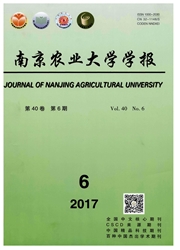

 中文摘要:
中文摘要:
根据丁香假单胞菌番茄致病变种(Pseudomonas syringae pv.tomato)DC3000中新的毒性基因tvrR(TetR-like viru-lence regulator)的氨基酸序列,从瓜类细菌性果斑病菌(Acidovorax avenae subsp.citrulli,Aac)的全基因组中发现并克隆了tvrR基因的同源物。通过同源重组的方法,构建了tvrR基因的插入突变体,并且经过PCR及Southern杂交验证确认。突变体和野生型一样可以激发烟草过敏反应。致病性试验结果显示:突变体比野生型的病程延长,但最终致病情况与野生型无差异。接种的寄主组织中菌体生长能力检测发现,突变体的繁殖速度慢于野生型,但最终其菌体数量也能达到野生型菌株的最大值。在营养丰富的LB培养基和营养贫乏的MMX基本培养基中生长测定均发现,突变体生长速度慢于野生型,但最终也能达到野生型的最大生长量。瓜类细菌性果斑病菌tvrR基因突变体致病性的改变与其生长能力变化的一致性表明,其致病性的变化是由于其生长能力的改变引起的。
 英文摘要:
英文摘要:
According to the sequence of the novel virulence gene tvrR ( TetR-like virulence regulator) of Pseudomonas syringae pv. tomato DC3000,a tvrR homolog was found and cloned from the genomic DNA of Acidovorax avenae subsp. citrulli. The tvrR inserted mutant was constructed by homologous recombination and confirmed by PCR and Southern blot. Both the mutants and the wild-type strains could elicit the hypersensitive response ( HR) in nonhost tobacco. Pathogenicity tests showed that the disease symptom caused by mutants was delayed when compared to the wild-type strains,but there were finally no significant differences in pathogenicity between the mutants and the wild-type strains. The inserted mutants grew more slowly than the wild-type strains,but their population could finally reach the maximum of the wild-type strains in inoculated leaf tissues of Hami-melon. The inserted mutants grew more slowly than the wild-type strains,but they could finally reach the maximum biomass of the wild-type strains in both nutrient-rich LB medium and nutrient-poor MMX medium. The consistency of the changes in pathogenicity and growth ability of tvrR mutants indicated that the changes in pathogenicity might be caused by the changed growth ability in A. avenae subsp. citrulli.
 同期刊论文项目
同期刊论文项目
 同项目期刊论文
同项目期刊论文
 期刊信息
期刊信息
